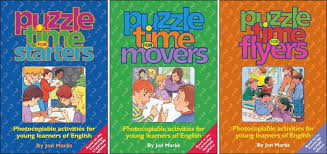Puzzle Time for Starters, for Movers, for Flyers

Because the three above-mentioned books are intertwined and basically built up in the same way, they can easily be summarized in one article. They follow and focus on the Cambridge syllabus needed for the three exam levels for young learners of English: Level 1 ‘Starters’ (ages 7 to 10), Level 2 (A1) ‘Movers’ (ages 8 to 10), and Level 3 (A2) ‘Flyers’ (ages 8 to 10). In my view, these age group classifications are not binding and could easily be extended upwards and downwards.
I was looking for some fun activities to revise, consolidate, and recycle vocabulary and grammar in a fun way with my lively children’s English classes, and came across these three volumes. To me they seem to hold just what they promise: they take little preparation time are easy to follow and instructive. Typical activities include quizzes, anagrams, join the dots, matching, crosswords, jumbled pictures, colouring puzzles, word searches, and listening dictations.
Each of the books contains the same brief introduction. Only the short section on ‘Ideas given for classroom activities’ varies slightly (instead of ‘Simon says’ for the Starters and Movers, the author suggests ‘Quizzes’ for the Flyers). The thirty photocopiable puzzle activities and seven self-explanatory mini-puzzles intended as lesson fillers naturally differ in difficulty, content, and extent with carefully selected language to serve the needs of the different levels. The easiest language is used in ‘Starters’, increasing in difficulty and complexity in ‘Movers’ and becoming the most challenging in ‘Flyers’. Each of the activities is accompanied by detailed and easy-to-follow teacher’s notes.
These three books are highly recommendable to give your young learners’ class that extra boost to make it a sure-fire success. You may want to pick an activity at the end of the class to consolidate new language input or use the additional ideas to expand them to a full-length lesson. Should the lesson material be completed unexpectedly quickly, you could still draw on the ‘General Activities’ following the introduction.
Personally, I think the material is equally suited for general as well as for exam classes. What’s more, I must admit that I have also incorporated one idea or the other in adults’ lessons, only slightly modified to their tastes and needs, and was surprised by the enthusiasm with which they went about solving the puzzles, e.g. ‘Stairs’, which works like a crossword but in staircase form. The objective of the game is to finish first by finding words for each of the steps across and down, always continuing with the last letter used.
There might not be sufficient listening practice material, but what I like best about the books is that the exercises are not only stimulating for the student but also for the teacher, and do not take much time to prepare. And last but not least, they are sheer fun!
Dora Zahnd
